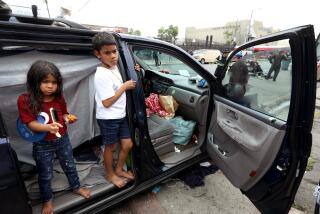How Russia Provides a Safe Haven for the ‘Lost’
- Share via
MOSCOW — Tucked away in a wasteland of warehouses is the place where Roma and Vitya and Kostya became a little less lost than they were the day police found them.
“My father threw me out. He was drunk,” said Roma Sveshnikov, who recently turned 12 at the Moscow Reception-Distribution Center for Children, the only facility of its kind in this city of 9 million people.
“So I went to Moscow. I stole things and got food that way. When they caught me the first time, I ran away from them.”
The police caught up with him again and brought him to the center, a sort of combination detention hall and family court. Here he plays ball in an oppressive, dirt-filled enclosure with several dozen other boys like himself--scrawny, appealing kids with eyes full of deceptive innocence and hair full of lice.
For Roma, it is a brief Purgatory between family and orphanage, or a way station on the road to a special school for juvenile offenders. There is no foster care system in Russia, and the concept of small group homes is only beginning to catch on.
So this is where police bring the lost or homeless, abandoned or delinquent. The compound of white stucco buildings with pink wooden doors squats amid clouds of dust and tangles of brittle weeds, a grim moonscape relieved only by a small circle of orange black-eyed Susans.
Beyond the flowers, 12 preschoolers in striped sun hats scramble over a rusting playground. Like the 135 other children here now, they will stay no more than two months--just long enough for the center’s staff to find out who they are and decide where they should go.
Identifying some may be impossible.
“Three of the children are unknown; they cannot speak,” said Natasha Kudryavtseva, a soft-spoken 16-year-old runaway who has found a niche helping with the youngest kids.
As she speaks, a blond boy of 3 or 4 with bangs hanging in his solemn eyes and a circle of open sores on his chin sidles up to her and snatches a children’s book from her hands.
“This little boy cannot talk at all,” she said. “He and the others come and pull at me, try to say something to me. I’ve learned to understand them.”
Understanding is a rare commodity for these children. The youngest were abandoned or lost; many of the older ones come from single-parent homes outside Moscow, where the combination of abuse and poverty pushes them out the door and into a life of running and stealing, an army of Artful Dodgers.
No one knows for sure how many homeless children there are, although more than 100,000 pass through Russia’s 174 temporary holding centers a year, said Tatiana Vinogradov, a social worker in Moscow.
About 5,000 children go through the Moscow center annually, up 50% from five years ago. Boys outnumber girls 4 to 1; most are between 8 and 13, but some are as young as 3.
“Mostly, it’s the economic difficulties that push children into committing various crimes,” said Vasily Kushnir, the center’s new supervisor.
Hard times have put an increasing strain on families, particularly those outside Moscow, where most runaways come from, he said. To children from poor communities, the lure of big money in the big city is almost impossible to resist.
They haunt Moscow’s nine railway stations at night, sleeping in corners or empty train cars. They spend the rest of their time hustling, selling ice cream or video game tokens or themselves, sometimes for nothing more than a hot meal.
“The reasons are always the same, and all we can do is punish,” said Yevgeny Balashev, chairman of the city Commission on Youth Affairs. “We’re unable to deal with the problems of homeless children.”
Balashev said he once found himself talking to a 13-year-old girl on her own in the Kursky train station after midnight. “Naturally, when you’re 13, it’s not the best place to be at such a time. I called her mother, and the mother says she’s not expecting her daughter, and she doesn’t care where the child is. What can we do?”
A proposal for an experimental shelter for homeless teen-agers was rejected by the city as unnecessary, but Kushnir’s figures for this year suggest otherwise. So far, 159 children have been brought to the center repeated times.
“Our people take them home, or their parents come pick them up here, but there’s a problem in the family. So the children come back to Moscow. The police often know their faces, and we have their addresses. So we can take them right back,” he said.
And they run away again, often trading one violent scenario for another. Their bodies tell the tale that they will not: 10-year-old Kostya Zhidin swings along on a single crutch, half his left leg severed under a tram after he ran away a year ago. His right hand bears two circular, cigarette-sized scars.
“Twenty years ago, I saw 14 cases of venereal disease a year and thought that was a lot. Now I see 100,” said Dr. Dina Silkhina, who has worked at the center for 40 years.
She ticks off a list of other illnesses found in the children: skin disorders, stomach ailments, contagious diseases such as diphtheria, which is spreading through the center. Three youths already have been hospitalized.
For the youngest, at least, the staff tries to tend spirit along with body. A locked door opens to the preschoolers’ wing, where red vinyl splotched with a yellow floral pattern undulates over the floor, pale pink and green wooden lockers line the walls, and a small room holds a menagerie of guinea pigs, hamsters and a hedgehog.
“Before we send them home, we try to put our whole hearts into those children,” said Olga Tsarkova, the department administrator.
The center’s staff has a sense of helplessness; they cannot control what happens to their charges before they arrive, or after they leave.
“There are some children I remember for years and years,” Silkhina said. “There was a very weak boy, just 3, beaten by his alcoholic parents. He was so, so weak, with lots of scars on his head. We took pictures of him as a special case and sent him to an orphanage.
“I remember so many children, it’s difficult to name them all.”
More to Read
Sign up for Essential California
The most important California stories and recommendations in your inbox every morning.
You may occasionally receive promotional content from the Los Angeles Times.










